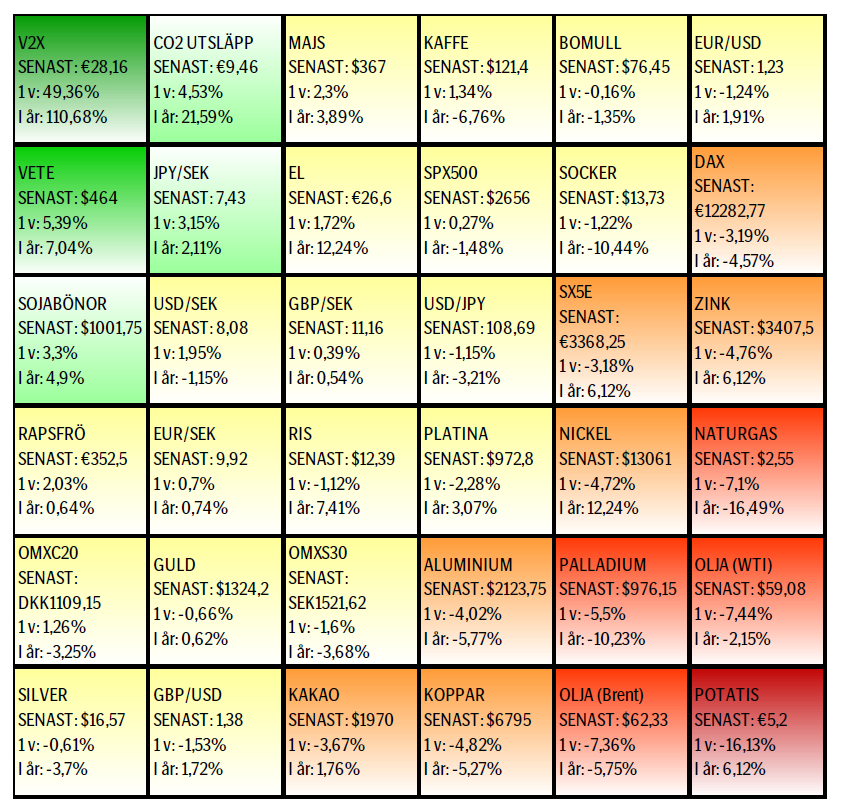Analys
SEB Råvarubrev 13 februari 2018

 När kommer höjningen Riksbanken?
När kommer höjningen Riksbanken?
MARKNADEN I KORTHET
Börsfallet har om inte kommit av sig så åtminstone tagit en paus. Den oroande slutsatsen av de senaste veckorna är att både aktier och obligationer fallit i tandem så denna gång har inte obligationer (eller blandfonder) varit den säkra hamn de oftast brukat vara. Den ökade volatiliteten kommer också att fortsätta tvinga placerare att dra ned på sina exponeringar enligt olika riskmodeller. Om amerikansk löneökningskostnad anges som den primära utlösaren av oron så finns fog för att förvänta sig ytterligare stigande lönepress. En god indikation är att allt fler deltidsanställda får utökad arbetstid. Riksbanken kommer med besked onsdag fm. Ingen ränteförändring kommer nu utan frågan är när? Vår investerarundersökning visar att i september är huvudspåret men till skillnad mot i dec-17 så är det nu betydligt fler som tror att det dröjer inpå 2019. Imorgon onsdag kommer också amerikansk prisstatistik (KPI) för januari. En avvikelse från det förväntade, framför allt på uppsidan kan få oron att snabbt flamma upp igen. Kina börjar på torsdag sitt långa (t.o.m. 21/3) nyårsfirande av hundens år. Se dessutom upp med SDP’s medlemsomröstning om den nya storkoalitionen med CDU/CSU, inte på något vis ett garanterat ja och därigenom en underskattad risk för nyval.
Råvaror: Korrektionen i oljepriset har visat sig bli kraftigare än vad vi initialt trodde. Den nettolånga spekulativa positionen har nu börjat minska men är fortfarande oerhört stor i ett historiskt perspektiv varför ett svagare pris kommer att dra fram mer utbud i form av nedstängning av långa terminer. Guldet har inte svarat speciellt mycket på börsoron men vi kan ju hursomhelst notera att priset är ett av de få som inte fallit nämnvärt. Guld/silver relationen har åter fallerat över 80 (uns silver per uns guld) något som upprepats gång efter gång de senaste decennierna. Palladium/platina spreaden går nu allt fortare ihop, vilket faller sig naturligt tycker vi, givet den kraftigt översålda platinan. Bas-metallerna fortsätter att korrigera lägre och bör fortsätta att göra så. Kakao är tillbaka och testar sitt 55d mv band utbrott. Socker ser ut att ha avslutat en mindre uppåt korrektion och torde alltså vara sårbar för förnyade försäljningar. Elpriserna, både spot (som dock efter köldknäppen fallit tillbaka) och termin har klättrat något högre. Så ock utsläppsrätterna som nu har fördubblats sedan början av 2017
Valuta: Dollar och yen har åter visat sig fungera som trygga hamnar i tider av oro och i och med att vi ser ytterligare börsoro framför oss så bör dessa två valutor fortsätta att göra bättre ifrån sig.
Börser: Det troligaste scenariot kvarstår, dvs. en korrektiv studs och sedan en ny nedgångssekvens. Det blir alltså väldigt viktigt att se reaktionerna under förra veckans botten. Blir denna temporär eller ett misslyckande. OMXS30 har också fått ett ”dödskors” i form av 55d mv brytandes under 233d mv.
Räntor: Obligationsräntorna har, trots börsoro, fortsatt att hålla sig nära eller t.o.m. lyckats stiga över de senaste topparna. En amerikansk 10-åring ligger på 2,82 % efter att igår nått 2,89 % som högst, den högsta nivån på fyra år.
OBSERVATIONER I SAMMANDRAG
- Olja – större korrektion än förväntat.
- Nickel – falskt brott upp ur den stigande kanalen.
- Guld – relativt aktier stark utveckling.
- DAX – faran är inte på något vis över än.
- USD/SEK – oron talar för starkare dollar.
- OMX30 – troligtvis en negativ triangel.
En placering i certifikat och warranter är förknippat med risker. Du kan förlora hela ditt investerade kapital. Läs mer om riskerna i SEB:s offentliggjorda Grundprospekt för certifikat- och warrantprogram på seb.se/cert eller seb.se/mini
OLJA BRENT
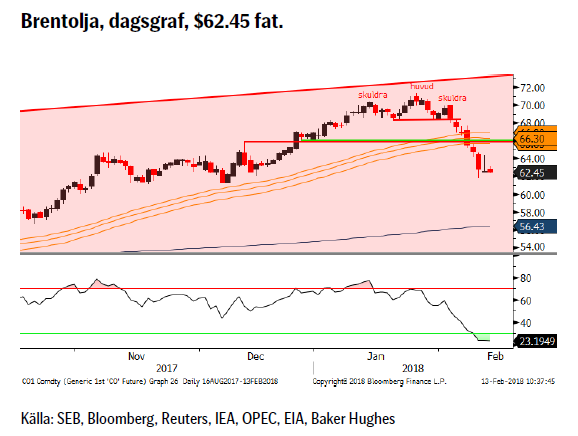 I och med brottet ned igenom 55d mv bandet har vi gått från en mindre till en större korrektion. Varningstecknet i form av fortsatt spekulativt köpande i en fallande marknad fungerade väl och spekulanterna har nu börjat sälja ned sin mycket stora långa nettoposition (som är fortsatt väldigt stor). EIA rapporten igår måndag visade på fortsatt ökning av borrningsaktiviteten och även antalet borrade men icke produktionsigångsatta källor. I årstakt förväntas skifferoljan öka med cirka 1,3m fpd vilket torde ge en total amerikansk produktion för 2018 om ca.10,85m fpd. Trots det så riskerar vi ett underskott för 2018 om OPEC fullföljer sina produktionsbegränsningar.
I och med brottet ned igenom 55d mv bandet har vi gått från en mindre till en större korrektion. Varningstecknet i form av fortsatt spekulativt köpande i en fallande marknad fungerade väl och spekulanterna har nu börjat sälja ned sin mycket stora långa nettoposition (som är fortsatt väldigt stor). EIA rapporten igår måndag visade på fortsatt ökning av borrningsaktiviteten och även antalet borrade men icke produktionsigångsatta källor. I årstakt förväntas skifferoljan öka med cirka 1,3m fpd vilket torde ge en total amerikansk produktion för 2018 om ca.10,85m fpd. Trots det så riskerar vi ett underskott för 2018 om OPEC fullföljer sina produktionsbegränsningar.
Konklusion: Nedgången börjar bli översåld.
OBSERVATIONER
+ Saudierna vill fortsätta samarbetet in i 2019.
+ Kinas import ökar åter.
+ Förlängningen av produktionsbegränsningarna.
+ Att förlängningen nu också omfattar Libyen och Nigeria.
+ Geopolitikens återkomst i form av en riskpremie i oljepriset.
+ Kurvans negativa lutning (backwardation) gör det lönsammare att ligga lång.
+ Långa spekulativa nettopositioner är rekordstora, men minskar
+ Ökad global efterfrågan och uppreviderad global tillväxt.
+ Produktionen i Venezuela faller och faller och faller.
+ Tekniskt börjar nedgången bli översåld.
– EIA reviderar åter upp US produktion (10,8–10,9m fpd).
– De stora spekulativa positionerna.
– Fortsatt ökning av nya borriggar och DUC’s.
– Troligt att dollarn återtar en del förlorad mark givet oron.
– De geopolitiska riskerna har minskat något.
– Tekniskt negativt brott under 55d mv bandet.
– Tekniskt nästa stöd i låga 61 området.
Tillgängliga certifikat:
BULL OLJA X1, X2, X4, X5, & X10 S
BEAR OLJA X1, X2, X4, X5 & X10 S
NICKEL
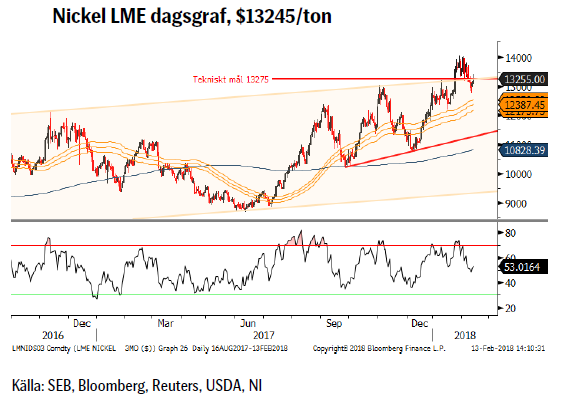 För närvarande verkar 14.000 nivån vara nog. Efter ett antal försök så har vi nu backat tillbaka till lägre nivåer. Den fortsatta uppgången i kobolt (spot har sedan ett år tillbaka gått från 33000 till 81280 $/t) gör dock att spekulationerna är höga om att nickel ska kunna, åtminstone till viss del, konkurrera med kobolt. Bilföretagen kämpar med näbbar och klor för att tillförsäkra sig framtida leveranser av kobolt och litium. Hursomhelst så är den näraliggande risken fortsatt på nedsidan men potentialen söderut begränsas naturligtvis en del av batteriproblematiken.
För närvarande verkar 14.000 nivån vara nog. Efter ett antal försök så har vi nu backat tillbaka till lägre nivåer. Den fortsatta uppgången i kobolt (spot har sedan ett år tillbaka gått från 33000 till 81280 $/t) gör dock att spekulationerna är höga om att nickel ska kunna, åtminstone till viss del, konkurrera med kobolt. Bilföretagen kämpar med näbbar och klor för att tillförsäkra sig framtida leveranser av kobolt och litium. Hursomhelst så är den näraliggande risken fortsatt på nedsidan men potentialen söderut begränsas naturligtvis en del av batteriproblematiken.
Konklusion: Tillbaka i kanalen och risk för mer säljande.
OBSERVATIONER
+ Billigare för batteritillverkare än kobolt.
+ 2017 kommer att landa på ett underskott och även 2018 spås göra så.
+ Lägsta LME lagren sedan 2014.
+ Rostfritt har gått starkare än förväntat.
+ IMF har justerat upp global tillväxt och utsikterna i närtid goda.
+ Lång spekulativ nettopositionering ökade till den högsta på ett år och det är långa kontrakt som öppnas upp.
+ Fallande dollar har pressat upp metallpriserna.
+ Ökad optimism i råvaror vilket leder till inflöden i råvarufonder.
+ Optimism om elbilssektorn (vilket är för tidigt, tror jag).
+ Kostnadsgolvet har stigit.
– Den långa nettopositionen har börjat minska och det genom både stängda långa och nyöppnade korta kontrakt.
– Större än förväntad kinesisk produktion.
– Lagren är stora men ses fortsätta falla 2018/2019.
– Indonesisk export kommer att öka årligen de närmaste åren.
– Australien har flera nya projekt på gång.
– Om det klarnar runt miljölagarna på Filippinerna.
– Se upp för mars som tillsammans med maj är den sämsta månaden de senaste tio åren.
– Lägre infrastruktur och bostadsinvesteringar i Kina.
– Negativt tillbaka i kanalen dvs. falskt uppsidesbrott.
Tillgängliga certifikat:
BULL NICKEL X1, X2 & X4 S
BEAR NICKEL X1, X2 & X4 S
GULD
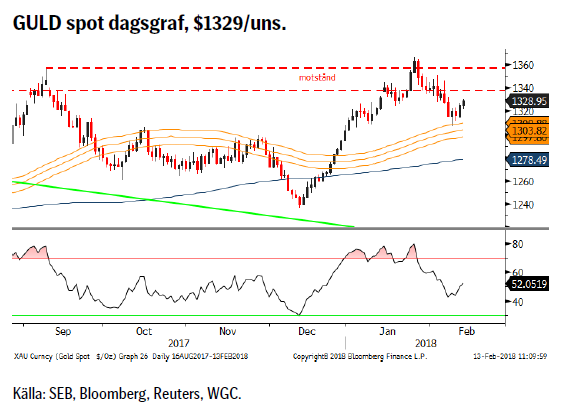 Den stora börs- och obligationsoron tog initialt även guldet med sig nedåt men nedgången blev ju väldigt begränsad jämfört med framför allt aktierna. Vi har dock även sett att guldpriset tappat något mot silverpriset då relationen åter blivit bortstött ovanför 80 (antalet uns silver för ett uns guld) något som skett gång efter annan under de senaste decennierna. Följaktligen ser guld dyrt ut jämfört med silver, i en relativprissättning.
Den stora börs- och obligationsoron tog initialt även guldet med sig nedåt men nedgången blev ju väldigt begränsad jämfört med framför allt aktierna. Vi har dock även sett att guldpriset tappat något mot silverpriset då relationen åter blivit bortstött ovanför 80 (antalet uns silver för ett uns guld) något som skett gång efter annan under de senaste decennierna. Följaktligen ser guld dyrt ut jämfört med silver, i en relativprissättning.
Konklusion: Positiv bias ovanför 55d mv bandet.
OBSERVATIONER
+ Efterfrågan på guld inför det Kinesiska nyårsfirandet.
+ Newcrest Mining rapporterade om ett betydligt högre kostnadsgolv 2017.
+ Inflationstrycket i USA fortsätter upp, nu senast med löneökningstakten lite över förväntat.
+ Rykten om minskad moms (f.n. 18 %) på investeringsguld i Ryssland
+ Fortsatt risk för Bitcoin nedgång.
+ Säsongsmässigt så är januari och februari normalt sett relativt bra månader för guldet.
+ Utvecklingen av den kinesiska guld ETF marknaden.
+ Shariastandarden för guld är långsiktigt positivt.
+ Tekniskt positivt att 55d mv bandet fortsätter att vara stöd.
– Den spekulativa (både netto och brutto) långa positioneringen har fortsatt att minska och är nu tillbaka på nivåer vi inte sett sedan augusti.
– Reaktionen på börsnedgången fortsatt begränsad.
– En större dollarkorrektion bör snart vara på väg.
– Klubbandet av den amerikanska skattererformen.
– Dåligt gensvar på spänningarna Saudiarabien/Iran.
– Realräntorna är i stigande.
– $1350/75 området måste passeras innan en positivare vy appliceras.
– Tekniskt sett så är det negativt att marknaden stöttes bort från motståndsområdet.
Tillgängliga certifikat:
BULL GULD X1, X2, X4, X5 & X10 S
BEAR GULD X1, X2, X4, X5 & X10 S
DAX
 För det första så ska vi vara försiktiga inför SDP’s medlemsomröstning om huruvida man ska acceptera det framförhandlade förslaget och ingå en ny storkoalition med Fru Merkel. Ett ja är inte på något vis garanterat och kom ihåg att den extra partikongressen gav grönt ljus med minsta möjliga marginal. Motståndet mot GroKo (Grosses koalition) är framför kompakt inom ungdomsrörelsen. Det italienska valet rycker också allt närmare. Summa summarum har vi en del orosmoment framför oss och det förutom det generellt skakiga börsläget.
För det första så ska vi vara försiktiga inför SDP’s medlemsomröstning om huruvida man ska acceptera det framförhandlade förslaget och ingå en ny storkoalition med Fru Merkel. Ett ja är inte på något vis garanterat och kom ihåg att den extra partikongressen gav grönt ljus med minsta möjliga marginal. Motståndet mot GroKo (Grosses koalition) är framför kompakt inom ungdomsrörelsen. Det italienska valet rycker också allt närmare. Summa summarum har vi en del orosmoment framför oss och det förutom det generellt skakiga börsläget.
Konklusion: Faran är inte på något vis över än.
OBSERVATIONER
+ Om SDP röstar ja till förslaget till ny koalition.
+ Historiken, upp 7/10 senaste åren, är positiv för mars.
+ Fortsatt bra ekonomisk statistik (EU & Ty inköpschefsindex).
+ Eurozons index för banker har brutit ut på uppsidan.
+ Nu tillväxt i alla euro-länder.
+ ECB lär hålla räntorna låga för lång tid framöver.
+ Den långa vågräkningen är fortsatt positiv (så länge inte 10474 passeras på nedsidan).
– Risken för att SDP’s medlemmar röstar nej till koalitionen.
– Det kommande Italienska valet.
– Den starka euron bör börja oro ECB.
– Tyska långa räntor är fortsatt i stigande mer än 100 % upp sedan mitten av december (0,3 – 0,75 %).
– Brittisk bilförsäljning har fallit kraftigt (en av de största exportmarknaderna för tysk bilindustri).
– Dieselgate (vi har inte sett slutet på detta än).
– Brott under 233d mv.
– Negativt kort/medelsiktigt vågmönster.
– Exit den positiva kanalen.
– Tekniskt har vi nu säljsignaler i flera tidsintervall vilka också underbyggs av de negativa divergenserna.
Tillgängliga certifikat:
BULL DAX X2, X5, X10 & X15 S
BEAR DAX X1, X2, X5, X10 & X15 S
USD/SEK
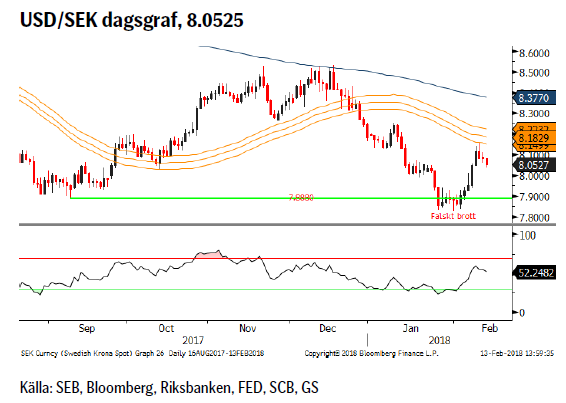 US financial conditions index (ett mått på tajtare/lättare likviditetssituation utifrån ett antal variabler i ränte och aktiemarknaderna i USA) har fortsatt att stramas åt vilket givit understöd till en starkare dollar. Fortsatt oro (vilket undertecknad tror på) bör fortsatt ge incitament till starkare dollar och yen. Håll koll på morgondagens Riksbanksbesked, inte för räntan utan för en eventuell förändring av den framtida räntebanan. Ett nyval i Tyskland (om SDP’s medlemmar gör tummen ned för överenskommelsen med CDU/CSU) kan också tänkas försvaga euron dvs. stärka dollarn. Håll också koll på onsdagens inflationsstatistik i USA med tanke på att högre löneökningar noterades i den senaste arbetsmarknadsstatistiken.
US financial conditions index (ett mått på tajtare/lättare likviditetssituation utifrån ett antal variabler i ränte och aktiemarknaderna i USA) har fortsatt att stramas åt vilket givit understöd till en starkare dollar. Fortsatt oro (vilket undertecknad tror på) bör fortsatt ge incitament till starkare dollar och yen. Håll koll på morgondagens Riksbanksbesked, inte för räntan utan för en eventuell förändring av den framtida räntebanan. Ett nyval i Tyskland (om SDP’s medlemmar gör tummen ned för överenskommelsen med CDU/CSU) kan också tänkas försvaga euron dvs. stärka dollarn. Håll också koll på onsdagens inflationsstatistik i USA med tanke på att högre löneökningar noterades i den senaste arbetsmarknadsstatistiken.
Konklusion: Tillbaka över åttan!
OBSERVATIONER
+ Global börsoro har en tendens till att stärka dollar och yen.
+ Inflationen är så sakteliga i stigande i USA varför marknaden nu börjar prisa in fyra snarare än tre höjningar under 2018.
+ Fram tills Riksbanken gör sin första höjning kommer räntedifferensen USA – Sverige att öka.
+ Atlanta FED indikatorn pekar på 5,4 % årstillväxt under kvartal 1 2018.
+ Feds minskning av balansräkningen.
+ Financial conditions har fortsatt att tajta till sig.
+ Fortsatt stor kort dollarposition mot euron.
+ Det kommande Italienska valet.
+ Amerikansk rapportsäsong har varit mycket starkare än den svenska.
+ Tekniskt sett i en möjlig bottenformation i och med det falska brottet under 7.8880.
– Långa €/$ positioner har börjat minska om än marginellt.
– Europa har fortsatt att överraska positivt.
– Överoptimism över det amerikanska skattepaketet.
– Skuldtaket är ännu inte på plats i USA.
– Ökat budgetunderskott och därigenom ökad upplåning i USA.
– Fallande dollar trend.
– Tekniskt är vi fortfarande negativt placerade under 55d mv bandet.
Tillgängliga certifikat:
BULL USD/SEK X1 & X4 S
BEAR USD/SEK X1 & X4 S
OMXS30
 Än så länge har vi till punkt och pricka följt skolboken. Vi först den lilla rekyl vi såg komma och den fyllde sedan det öppna gapet innan vi åter föll. Dock har vi ännu inte satt någon ny botten, vilket vi anser bör ske innan vi kan börja leta efter en botten formation. Det troligaste utfallet för närvarande är att vi skapar en negativ triangel, ett negativt fortsättningsmönster, för att därefter falla ned till en ny botten. Hur denna nya botten sedan tas emot, fyndköpare eller paniksäljare, avgör huruvida vi kan börja skapa en bottenformation eller ej. Håll koll på Riksbanksbeskedet onsdag fm då framför allt en något hökaktigare räntebana skulle kunna stärka kronan. Ny bostadsstatistik kommer också på onsdag (Valueguard).
Än så länge har vi till punkt och pricka följt skolboken. Vi först den lilla rekyl vi såg komma och den fyllde sedan det öppna gapet innan vi åter föll. Dock har vi ännu inte satt någon ny botten, vilket vi anser bör ske innan vi kan börja leta efter en botten formation. Det troligaste utfallet för närvarande är att vi skapar en negativ triangel, ett negativt fortsättningsmönster, för att därefter falla ned till en ny botten. Hur denna nya botten sedan tas emot, fyndköpare eller paniksäljare, avgör huruvida vi kan börja skapa en bottenformation eller ej. Håll koll på Riksbanksbeskedet onsdag fm då framför allt en något hökaktigare räntebana skulle kunna stärka kronan. Ny bostadsstatistik kommer också på onsdag (Valueguard).
Konklusion: Vi bör se minst en botten till.
OBSERVATIONER
+ Säsongsmässigt feb historiskt (upp 8/10 senaste år) starkt.
+ Mjuk Riksbank väntar med första höjningen trots högre KPIF.
+ Svensk ek statistik fortsätter att vara relativt positiv och EU dito allt starkare.
+ Det långsiktiga vågmönstret är fortsatt positivt.
+ Om vi spikar under föregående botten eller kliver tillbaka över 55d mv bandet.
– Om Riksbanken är hökaktigare.
– Fortsatt risk för svensk bomarknad.
– PMI vände åter ned.
– Vi har brutit under 55d mv bandet och 233d mv.
– En negativ månadsvändningssignal i november.
– Negativa veckosignaler.
– Vi har nu ett, 55/233d, dödskors på plats.
– Vi har brutit under föregående korrektionsbotten.
Tillgängliga certifikat:
BULL OMX X5, X10 & X15 S
BEAR OMX X1, X5, X10 & X15 S
UTVECKLING SENASTE VECKAN SAMT SEDAN ÅRETS BÖRJAN
[box]SEB Veckobrev Veckans råvarukommentar är producerat av SEB:s Commodities Sales desk och publiceras i samarbete och med tillstånd på Råvarumarknaden.se[/box]
KÄLLOR
Bloomberg, Reuters, SEB
VILLKOR
För varje enskilt certifikat/mini future finns Slutliga Villkor som anger de fullständiga villkoren. Slutliga Villkor finns tillgängligt på kurssidan för respektive certifikat/mini future på www.seb.se, Börs & finans, fliken Strukturerade placeringar.
RISKER
En sammanfattning av de risker som är förknippade med Börshandlade certifikat generellt finns i Produktbroschyren för respektive certifikat eller mini future som är tillgängligt på seb.se/cert respektive seb.se/mini. För en fullständig bild av riskerna behöver du ta del av SEB:s offentliggjorda Grundprospekt för Certifikat- och Warrantprogram som är publicerat på www.seb.se/cert respektive seb.se/mini.
DISCLAIMER
Detta marknadsföringsmaterial, framtaget av SEB:s Commodities Sales desk, har upprättats enbart i informationssyfte.
Även om innehållet är baserat på källor som SEB bedömt som tillförlitliga ansvarar SEB inte för fel eller brister i informationen. Den utgör inte oberoende, objektiv investeringsanalys och skyddas därför inte av de bestämmelser som SEB har infört för att förebygga potentiella intressekonflikter. Yttranden från SEB:s Commodities Sales desk kan vara oförenliga med tidigare publicerat material från SEB, då den senare hänvisas uppmanas du att läsa den fullständiga rapporten innan någon åtgärd vidtas.
Dokumentationen utgör inte någon investeringsrådgivning och tillhandahålls till dig utan hänsyn till dina investeringsmål. Du uppmanas att självständigt bedöma och komplettera uppgifterna i denna dokumentation och att basera dina investeringsbeslut på material som bedöms erforderligt. Alla framåtblickande uttalanden, åsikter och förväntningar är föremål för risker, osäkerheter och andra faktorer och kan orsaka att det faktiska resultatet avviker väsentligt från det förväntade. Historisk avkastning är ingen garanti för framtida resultat. Detta dokument utgör inte ett erbjudande att teckna några värdepapper eller andra finansiella instrument. SEB svarar inte för förlust eller skada – direkt eller indirekt, eller av vad slag det vara må – som kan uppkomma till följd av användandet av detta material eller dess innehåll.
Observera att det kan förekomma att SEB, dess ledamöter, dess anställda eller dess moder- och/eller dotterbolag vid olika tillfällen innehar, har innehaft eller kommer att inneha aktier, positioner, rådgivningsuppdrag i samband med corporate finance-transaktioner, investment- eller merchantbanking-uppdrag och/eller lån i de bolag/finansiella instrument som nämns i materialet.
Materialet är avsett för mottagaren, all spridning, distribuering mångfaldigande eller annan användning av detta meddelande får inte ske utan SEB:s medgivande. Materialet riktar sig inte till personer vars medverkan kräver ytterligare prospekt, registrerings- eller andra åtgärder än vad som följer av svensk rätt. Det åligger var och en att iaktta sådana restriktioner. Materialet får inte distribueras i eller till land där distribution kräver ovan nämnda åtgärder eller strider mot reglering i sådant land. Materialet riktar sig således inte till fysiska eller juridiska personer hemmahörande i USA eller i något annat land där publicering eller tillhandahållande av materialet är förbjudet eller strider mot tillämpliga bestämmelser i landet.
Oaktat detta får SEB tillåta omfördelning av materialet till utvald tredje part i enlighet med gällande avtal. Materialet får inte spridas till fysiska eller juridiska personer som är medborgare eller har hemvist i ett land där sådan spridning är otillåten enligt tillämplig lag eller annan bestämmelse.
Skandinaviska Enskilda Banken AB (publ) är ett publikt aktiebolag och står under tillsyn av Finansinspektionen samt de lokala finansiella tillsynsmyndigheter i varje jurisdiktionen där SEB har filial eller dotterbolag.
Analys
Tightening fundamentals – bullish inventories from DOE

The latest weekly report from the US DOE showed a substantial drawdown across key petroleum categories, adding more upside potential to the fundamental picture.

Commercial crude inventories (excl. SPR) fell by 5.8 million barrels, bringing total inventories down to 415.1 million barrels. Now sitting 11% below the five-year seasonal norm and placed in the lowest 2015-2022 range (see picture below).
Product inventories also tightened further last week. Gasoline inventories declined by 2.1 million barrels, with reductions seen in both finished gasoline and blending components. Current gasoline levels are about 3% below the five-year average for this time of year.
Among products, the most notable move came in diesel, where inventories dropped by almost 4.1 million barrels, deepening the deficit to around 20% below seasonal norms – continuing to underscore the persistent supply tightness in diesel markets.
The only area of inventory growth was in propane/propylene, which posted a significant 5.1-million-barrel build and now stands 9% above the five-year average.
Total commercial petroleum inventories (crude plus refined products) declined by 4.2 million barrels on the week, reinforcing the overall tightening of US crude and products.


Analys
Bombs to ”ceasefire” in hours – Brent below $70

A classic case of “buy the rumor, sell the news” played out in oil markets, as Brent crude has dropped sharply – down nearly USD 10 per barrel since yesterday evening – following Iran’s retaliatory strike on a U.S. air base in Qatar. The immediate reaction was: “That was it?” The strike followed a carefully calibrated, non-escalatory playbook, avoiding direct threats to energy infrastructure or disruption of shipping through the Strait of Hormuz – thus calming worst-case fears.

After Monday morning’s sharp spike to USD 81.4 per barrel, triggered by the U.S. bombing of Iranian nuclear facilities, oil prices drifted sideways in anticipation of a potential Iranian response. That response came with advance warning and caused limited physical damage. Early this morning, both the U.S. President and Iranian state media announced a ceasefire, effectively placing a lid on the immediate conflict risk – at least for now.
As a result, Brent crude has now fallen by a total of USD 12 from Monday’s peak, currently trading around USD 69 per barrel.
Looking beyond geopolitics, the market will now shift its focus to the upcoming OPEC+ meeting in early July. Saudi Arabia’s decision to increase output earlier this year – despite falling prices – has drawn renewed attention considering recent developments. Some suggest this was a response to U.S. pressure to offset potential Iranian supply losses.
However, consensus is that the move was driven more by internal OPEC+ dynamics. After years of curbing production to support prices, Riyadh had grown frustrated with quota-busting by several members (notably Kazakhstan). With Saudi Arabia cutting up to 2 million barrels per day – roughly 2% of global supply – returns were diminishing, and the risk of losing market share was rising. The production increase is widely seen as an effort to reassert leadership and restore discipline within the group.
That said, the FT recently stated that, the Saudis remain wary of past missteps. In 2018, Riyadh ramped up output at Trump’s request ahead of Iran sanctions, only to see prices collapse when the U.S. granted broad waivers – triggering oversupply. Officials have reportedly made it clear they don’t intend to repeat that mistake.
The recent visit by President Trump to Saudi Arabia, which included agreements on AI, defense, and nuclear cooperation, suggests a broader strategic alignment. This has fueled speculation about a quiet “pump-for-politics” deal behind recent production moves.
Looking ahead, oil prices have now retraced the entire rally sparked by the June 13 Israel–Iran escalation. This retreat provides more political and policy space for both the U.S. and Saudi Arabia. Specifically, it makes it easier for Riyadh to scale back its three recent production hikes of 411,000 barrels each, potentially returning to more moderate increases of 137,000 barrels for August and September.
In short: with no major loss of Iranian supply to the market, OPEC+ – led by Saudi Arabia – no longer needs to compensate for a disruption that hasn’t materialized, especially not to please the U.S. at the cost of its own market strategy. As the Saudis themselves have signaled, they are unlikely to repeat previous mistakes.
Conclusion: With Brent now in the high USD 60s, buying oil looks fundamentally justified. The geopolitical premium has deflated, but tensions between Israel and Iran remain unresolved – and the risk of missteps and renewed escalation still lingers. In fact, even this morning, reports have emerged of renewed missile fire despite the declared “truce.” The path forward may be calmer – but it is far from stable.
Analys
A muted price reaction. Market looks relaxed, but it is still on edge waiting for what Iran will do

Brent crossed the 80-line this morning but quickly fell back assigning limited probability for Iran choosing to close the Strait of Hormuz. Brent traded in a range of USD 70.56 – 79.04/b last week as the market fluctuated between ”Iran wants a deal” and ”US is about to attack Iran”. At the end of the week though, Donald Trump managed to convince markets (and probably also Iran) that he would make a decision within two weeks. I.e. no imminent attack. Previously when when he has talked about ”making a decision within two weeks” he has often ended up doing nothing in the end. The oil market relaxed as a result and the week ended at USD 77.01/b which is just USD 6/b above the year to date average of USD 71/b.

Brent jumped to USD 81.4/b this morning, the highest since mid-January, but then quickly fell back to a current price of USD 78.2/b which is only up 1.5% versus the close on Friday. As such the market is pricing a fairly low probability that Iran will actually close the Strait of Hormuz. Probably because it will hurt Iranian oil exports as well as the global oil market.
It was however all smoke and mirrors. Deception. The US attacked Iran on Saturday. The attack involved 125 warplanes, submarines and surface warships and 14 bunker buster bombs were dropped on Iranian nuclear sites including Fordow, Natanz and Isfahan. In response the Iranian Parliament voted in support of closing the Strait of Hormuz where some 17 mb of crude and products is transported to the global market every day plus significant volumes of LNG. This is however merely an advise to the Supreme leader Ayatollah Ali Khamenei and the Supreme National Security Council which sits with the final and actual decision.
No supply of oil is lost yet. It is about the risk of Iran closing the Strait of Hormuz or not. So far not a single drop of oil supply has been lost to the global market. The price at the moment is all about the assessed risk of loss of supply. Will Iran choose to choke of the Strait of Hormuz or not? That is the big question. It would be painful for US consumers, for Donald Trump’s voter base, for the global economy but also for Iran and its population which relies on oil exports and income from selling oil out of that Strait as well. As such it is not a no-brainer choice for Iran to close the Strait for oil exports. And looking at the il price this morning it is clear that the oil market doesn’t assign a very high probability of it happening. It is however probably well within the capability of Iran to close the Strait off with rockets, mines, air-drones and possibly sea-drones. Just look at how Ukraine has been able to control and damage the Russian Black Sea fleet.
What to do about the highly enriched uranium which has gone missing? While the US and Israel can celebrate their destruction of Iranian nuclear facilities they are also scratching their heads over what to do with the lost Iranian nuclear material. Iran had 408 kg of highly enriched uranium (IAEA). Almost weapons grade. Enough for some 10 nuclear warheads. It seems to have been transported out of Fordow before the attack this weekend.
The market is still on edge. USD 80-something/b seems sensible while we wait. The oil market reaction to this weekend’s events is very muted so far. The market is still on edge awaiting what Iran will do. Because Iran will do something. But what and when? An oil price of 80-something seems like a sensible level until something do happen.
-

 Nyheter4 veckor sedan
Nyheter4 veckor sedanStor uppsida i Lappland Guldprospekterings aktie enligt analys
-

 Nyheter4 veckor sedan
Nyheter4 veckor sedanSilverpriset släpar efter guldets utveckling, har mer uppsida
-

 Nyheter3 veckor sedan
Nyheter3 veckor sedanUppgången i oljepriset planade ut under helgen
-

 Nyheter2 veckor sedan
Nyheter2 veckor sedanMahvie Minerals växlar spår – satsar fullt ut på guld
-

 Nyheter3 veckor sedan
Nyheter3 veckor sedanLåga elpriser i sommar – men mellersta Sverige får en ökning
-

 Analys3 veckor sedan
Analys3 veckor sedanVery relaxed at USD 75/b. Risk barometer will likely fluctuate to higher levels with Brent into the 80ies or higher coming 2-3 weeks
-

 Nyheter2 veckor sedan
Nyheter2 veckor sedanOljan, guldet och marknadens oroande tystnad
-

 Nyheter2 veckor sedan
Nyheter2 veckor sedanJonas Lindvall är tillbaka med ett nytt oljebolag, Perthro, som ska börsnoteras



